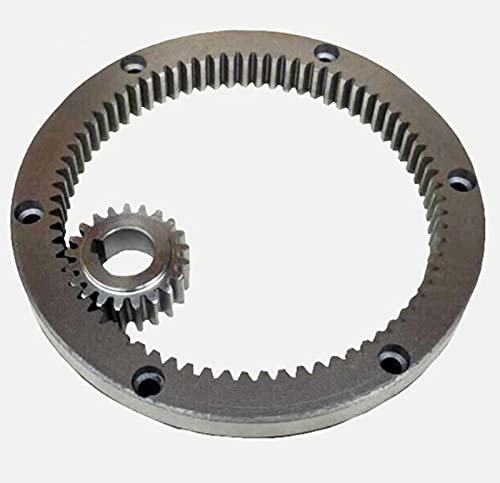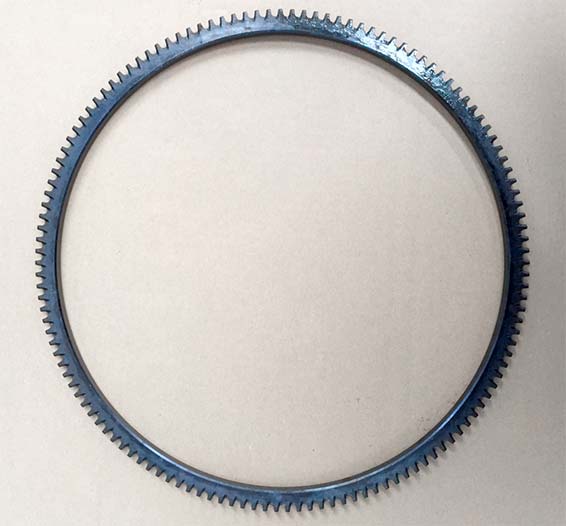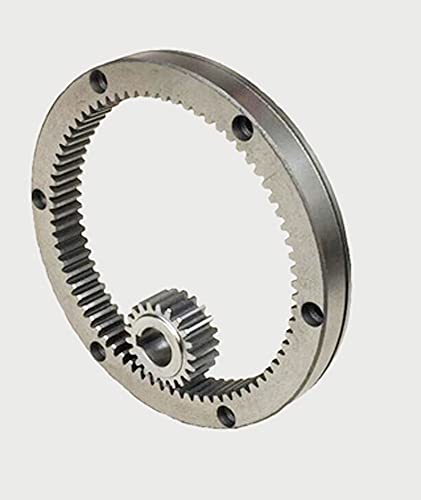Product Description
CITICIC is the casting & forging center in central-south China, possessing 50t electric arc furnace, 60t LF ladle refining furnace, and 60t VD/VOD refining furnace, etc. We can pour 350t liquid steel 1 time and yields more than 200,000t of high quality liquid steel and can produce the high quality steel of more than 260 steel grades such as carbon steel, structural alloy steel and the structural steel, refractory steel and stainless steel of special requirement. The maximum weight of casting, gray casting, graphite cast iron and non-ferrous casting is 200t, 30t, 20t and 205t separately.
Features:
Module Range: 10 Module to 70 Module.
Diameter: Min 800mm to16000 mm.
Weight: Max 120 MT single piece.
Three different designs: Fabricated steel – forged ring – rolled plate
Standards / Certificates: • CHINAMFG EN ISO • AWS • ASTM • ASME • DIN
Advantages:
– Products with Customers’ Designs
– Strong Machining & Heat Treatment Abilities
– Strict Quality Control
– Prompt Delivery
– Experience in Cooperation with Fortune 500 Companies
Process:
Forging / Casting
Normalizing & Tempering-Proof Machining
Quenching & Tempering
Finish Machining (Teeth Grinding)
We can offer you in various process conditions solutions for Many End Markets and Applications
–Mining
–Metallurgy
–Power Generation
–Sugar
–Cement Plant
–Port Machinery
–Oil and natural
–Papermaking
–OEM gear case
–General Industrial
Specifications Of Gear:
| No. |
Item |
Description |
|
1 |
Diameter |
≤15m |
|
2 |
Module |
≤45 |
|
3 |
Material |
Cast Alloy Steel, Cast Carbon Steel, Forged Alloy Steel, Forged Carbon Steel |
|
4 |
Structure From |
Integrated, Half to Half, Four Pieces and More Pieces |
|
5 |
Heat Treatment |
Quenching & Tempering, Normalizing & Tempering, Carburizing & Quenching & Tempering |
|
6 |
Tooth Form |
Annular Gear, Outer Gear Ring |
|
7 |
Standard |
ISO, EN, DIN, AISI, ASTM, JIS, IS, GB |
Inspection And Test Outline Of Girth Gear:
| No. |
Item |
Inspection Area |
Acceptance Criteria |
Inspection Stage |
Certificates |
|
1 |
Chemical |
Sample |
Material Requirement |
When Smelting |
Chemical Composition |
|
2 |
Mechanical |
Sample (Test Bar on the Gear Body) |
Technical Requirement |
After Heat Treatment |
Mechanical Properties |
|
3 |
Heat |
Whole Body |
Manufacturing Standard |
During Heat Treatment |
Heat Treatment Report |
|
4 |
Hardness |
Tooth Surface, 3 Points Per 90° |
Technical Requirement |
After Heat Treatment |
Hardness Teat Report |
|
After Semi Finish |
|||||
|
5 |
Dimension |
Whole Body |
Drawing |
After Semi Finish Machining |
Dimension Inspection |
|
Finish Machining |
|||||
|
6 |
Magnetic Power Test (MT) |
Tooth Surface |
Agreed Standard |
After Finish Gear |
MT Report |
|
7 |
UT |
Spokes Parts |
Agreed Standard |
After Rough Machining |
UT Report |
|
After Welded |
|||||
|
After Semi Finish |
|||||
|
8 |
PT |
Defect Area |
No Defect Indicated |
After Digging |
PT Record |
|
9 |
Mark Inspection |
Whole Body |
Manufacturing Standard |
Final Inspection |
Pictures |
|
10 |
Appearance Inspection |
Whole Body |
CIC’s Requirement |
Before Packing (Final Inspection) |
|
|
11 |
Anti-rust |
Whole Body |
Agreed Anti-rust Agent |
Before Packing |
Pictures |
|
12 |
Packing |
Whole Body |
Agreed Packing Form |
During Packing |
Pictures |
Facilities For Manufacturing Gear Ring:
| No |
Item |
Description |
|
1 |
Smelting & Casting Capability |
40t, 50t, 80t Series AC Electric Arc Furnace We can pour 900t refining liquid steel 1 time, and achieve vacuum poured 600t steel ingots. We can produce the high quality steel of more than 260 steel grades as carbon steel, structural alloy steel and the structural steel, refractory steel and stainless steel of special requirement. The maximum weight of casting steel, gray casting, graphite cast iron and non-ferrous casting is 600t, 200t, 150t and 20t separately. |
|
2 |
Forging Capability |
The only 1 in the word, the most technologically advanced and the largest |
|
3 |
Heat Treatment Capability |
9×9×15m, 8×8×12m, 6×6×15m, 15×16×6.5m, 16×20×6m, 7×7×17m Series Heat CHINAMFG and Heat Treatment Furnaces φ2.0×30m, φ3.0×5.0m Series Heat Treatment Furnaces |
|
4 |
Machining Capability |
1. ≥5m CNC Heavy Duty Vertical Lathes 12m CNC Double-column Vertical Lathe
2. ≥5m Vertical Gear Hobbing Machines
3. Imported High-precision Gear Grinding Machines
4. Large Boring & Milling Machines |
/* January 22, 2571 19:08:37 */!function(){function s(e,r){var a,o={};try{e&&e.split(“,”).forEach(function(e,t){e&&(a=e.match(/(.*?):(.*)$/))&&1
| Application: | Industry |
|---|---|
| Hardness: | According to Customer′s Requirement |
| Gear Position: | External Gear |
| Manufacturing Method: | Cast Gear |
| Toothed Portion Shape: | Spur Gear |
| Material: | Steel |
| Customization: |
Available
| Customized Request |
|---|

What is the purpose of using ring gears in machinery?
Ring gears serve multiple purposes and offer various advantages when used in machinery. Here’s a detailed explanation of the purpose of using ring gears:
- Power Transmission: One of the primary purposes of ring gears in machinery is to facilitate power transmission. Ring gears, along with other meshing gears, transmit torque and rotational motion from the driving gear to the driven components or systems. They enable the transfer of power from a power source to various parts of the machinery, driving the movement and operation of different mechanisms and processes.
- Gear Ratio Control: Ring gears allow for precise control over the gear ratio in machinery. By adjusting the size of the ring gear and its meshing gears, different gear ratios can be achieved. Gear ratios determine the relationship between the rotational speeds and torques of the driving and driven gears. This ability to control the gear ratio enables machinery to operate at desired speeds, optimize torque output, and adapt to specific application requirements.
- Mechanical Advantage: Ring gears provide a mechanical advantage in machinery. By leveraging the gear ratio control mentioned above, ring gears can amplify or reduce the torque output of the power source. This mechanical advantage allows machinery to generate higher forces or torques than the original power source alone. It enables the machinery to handle heavy loads, perform tasks requiring significant force, and enhance overall operational efficiency.
- Load Distribution: Ring gears contribute to load distribution within machinery. The meshing teeth of the ring gear engage with multiple teeth of other gears, distributing the transmitted loads across these meshing points. This load distribution helps prevent excessive stress concentration on specific gear teeth, ensuring even wear and reducing the risk of gear failure. By distributing the load, ring gears enhance the overall durability and reliability of the machinery.
- Motion Control: Ring gears play a crucial role in motion control within machinery. By transmitting rotational motion, ring gears enable precise movement and synchronization of various components and mechanisms. They ensure that different parts of the machinery operate in a coordinated manner, allowing for smooth and controlled motion. Ring gears contribute to accurate positioning, speed regulation, and overall motion precision in machinery.
- Compact Design: Ring gears offer a compact design solution. Due to their annular shape, they can be integrated into machinery with limited space. The compactness of ring gears is particularly beneficial in applications where space constraints are a concern. Their small footprint allows for efficient use of available space, enabling the design of more compact and lightweight machinery without sacrificing power transmission capabilities.
- Versatile Applications: Ring gears find wide applications across various industries and machinery types. They are used in automotive transmissions, industrial machinery, robotics, aerospace systems, power generation equipment, and more. The versatility of ring gears stems from the ability to configure them in different types, such as external or internal ring gears, helical gears, or bevel gears. This versatility makes ring gears adaptable to a wide range of machinery designs and requirements.
By serving these purposes, ring gears contribute to the efficient and reliable operation of machinery. They enable power transmission, gear ratio control, mechanical advantage, load distribution, motion control, and compact design, making them essential components in various mechanical systems.

How do you prevent backlash and gear play in a ring gear mechanism?
Preventing backlash and gear play in a ring gear mechanism is crucial for ensuring accurate and precise operation. Here’s a detailed explanation of how to prevent backlash and gear play in a ring gear mechanism:
- Precise Gear Design: The design of the ring gear and associated gears should be carefully engineered to minimize backlash. This involves selecting appropriate tooth profiles and gear geometry that promote proper meshing and minimize clearance between the gear teeth. The gear design should consider factors such as tooth thickness, pressure angle, and tooth contact ratio to achieve optimal gear meshing without excessive play.
- Tight Manufacturing Tolerances: Close manufacturing tolerances are essential to reduce backlash in a ring gear mechanism. The gear components, including the ring gear and mating gears, should be produced with high precision to ensure accurate tooth dimensions and minimize any gaps or play between the gear teeth. Tight manufacturing tolerances help achieve a tighter meshing fit, reducing backlash and gear play.
- Proper Gear Alignment: Accurate alignment of the ring gear and mating gears is crucial for minimizing backlash. The gears should be properly aligned along their axes to ensure precise engagement and minimize any misalignment that can contribute to play. Adequate alignment can be achieved through careful assembly techniques, such as using alignment fixtures, proper shimming, and precision measurement tools.
- Preload or Pre-tension: Applying preload or pre-tension to the ring gear mechanism can help reduce backlash and gear play. Preload involves applying a slight compressive force or tension to eliminate any clearance or gaps between the gear teeth during operation. This can be achieved through various methods, such as using spring-loaded components, adjustable shims, or axial preloading devices.
- Optimized Lubrication: Proper lubrication is essential for reducing friction and minimizing gear play. Lubricants with appropriate viscosity and film strength should be used to ensure smooth gear operation and reduce any unwanted movement or play between the gear teeth. Regular lubricant maintenance, such as monitoring oil levels and replenishing or replacing lubricants as needed, helps maintain optimal lubrication conditions and minimize backlash.
- Mechanical Backlash Compensation: In some applications, mechanical compensation mechanisms can be employed to actively compensate for any residual backlash. These mechanisms can include systems with adjustable clearances, anti-backlash devices, or dual-gear arrangements that counteract the effects of backlash. Mechanical backlash compensation techniques can help maintain precise positioning and eliminate any undesired play in the gear mechanism.
By implementing these measures, it is possible to significantly reduce or eliminate backlash and gear play in a ring gear mechanism. Careful gear design, tight manufacturing tolerances, proper alignment, preload or pre-tension, optimized lubrication, and mechanical compensation techniques all play a role in ensuring accurate and precise operation of the ring gear mechanism.

How do ring gears differ from other types of gears?
Ring gears, also known as annular gears or internal gears, possess distinct characteristics that set them apart from other types of gears. Here’s a detailed explanation of how ring gears differ from other gears:
1. Tooth Configuration: The most significant difference between ring gears and other gears is their tooth configuration. In a ring gear, the teeth are located on the inside circumference of a circular ring, whereas in other gears such as spur gears, helical gears, and bevel gears, the teeth are present on the outer surface of the gear. This internal tooth arrangement makes ring gears unique and allows them to mesh with pinion gears or other external gears.
2. Gear Assembly: The assembly of ring gears differs from other gears. In most cases, ring gears are used in combination with pinion gears or other external gears. The pinion gear meshes with the teeth on the inside of the ring gear. This gear set configuration enables the transmission of rotational motion and torque.
3. Load Distribution: Ring gears distribute the load over a larger area compared to other types of gears. The load is spread across the internal teeth of the ring gear, resulting in improved load-carrying capacity and enhanced gear durability. This load distribution characteristic makes ring gears suitable for applications that involve high loads or continuous operation.
4. Gear Ratio: Ring gears offer specific advantages in terms of gear ratios. They are commonly used in applications where high gear ratios are required. The gear ratio is determined by the number of teeth on the ring gear compared to the number of teeth on the mating gear (such as a pinion gear). The internal tooth configuration of the ring gear allows for larger gear diameters, enabling higher gear ratios to be achieved.
5. Space Utilization: Ring gears provide a compact design compared to some other types of gears. The internal tooth arrangement allows for a more space-efficient gear assembly. This compactness is advantageous in applications where space is limited or where a high gear ratio needs to be achieved within a confined area.
6. Applications: Ring gears are commonly used in automotive transmissions, differential systems, planetary gear systems, industrial machinery, robotics, power generation equipment, and heavy machinery. Their unique characteristics make them suitable for applications that require precise motion control, load distribution, and high gear ratios.
It’s important to note that the specific design, tooth profile, material selection, and manufacturing techniques may vary for different types of gears, including ring gears. Each type of gear is designed to meet specific application requirements, operating conditions, and performance needs.


editor by CX 2024-04-10